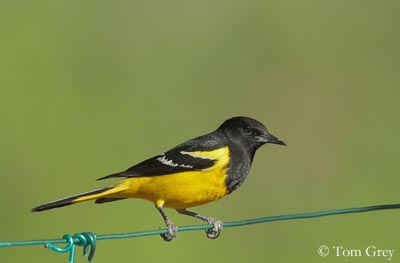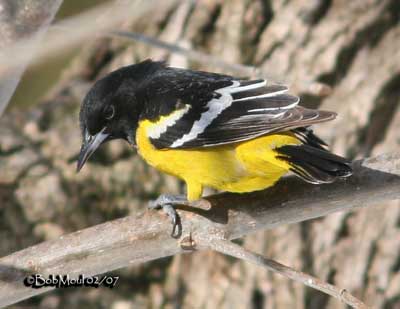
Fr: Oriole jaune verdâtre
All: Scott-Trupial
Esp : Turpial Tunero
Ital : Oriolo di Scott
Nd : Scott-troepiaal
Sd : Scotts trupial
Photographers :
Tom grey
Tom Grey's Bird Pictures
Bob Moul
Nature Photography
Text by Nicole Bouglouan
Sources :
NEW WORLD BLACKBIRDS – THE ICTERIDS by Alvaro Jaramillo and Peter Burke – Helm - ISBN : 0713643331
FIELD GUIDE TO THE BIRDS OF NORTH AMERICA - National Geographic Society - ISBN: 0792274512
A GUIDE TO THE BIRDS OF MEXICO AND NORTHERN CENTRAL AMERICA by Steve N. G. Howell, Sophie Webb - Oxford University Press - ISBN: 0198540124
Animal Diversity Web (University of Michigan Museum of Zoology)
The Birds of North America online
What Bird-The ultimate Bird Guide (Mitchell Waite)
Bird Web (Seattle Audubon Society)
BirdLife International (BirdLife International)
Scott’s Oriole
Icterus parisorum
Passeriforme Order – Icteridae Family
BIOMETRICS:
Length: 19-21 cm
Wingspan: 25-35 cm
Weight: 36-38 g
DESCRIPTION:
The Scott’s oriole has contrasted yellow and black plumage.
Adult male shows black hood, breast and back. The wings are black, with two white wing bars, and we can see a conspicuous yellow shoulder patch edged with white below. The tail is black, but the tail feathers have yellow bases. The central tail feathers are mainly black whereas the outer rectrices are yellow on most part of their length. The tips are black.
The underparts are bright yellow.
The sharp, pointed bill is black. Eyes are dark brown. Legs and feet are blue grey.

The female has olive-grey back and olive-yellow underparts. The wings are brownish black, and we can see two white wing bars. The tail is mainly olive-green, with yellowish in outer rectrices as in male. She shows some black spots or streaks on the head, back and throat.
The females are highly variable in plumage, due to quantity of black on head, back and throat.
The juveniles of both sexes have dull olive plumage without any pattern.
Females and immature are larger, greyer and more streaked above, with straighter bills, than females Hooded Oriole which have long, thin and down-curved bill.
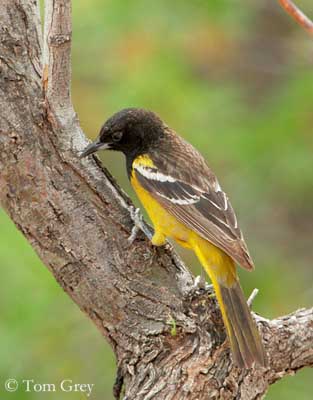
VOICE: SOUNDS BY XENO-CANTO
The Scott’s Oriole’s calls include harsh “chuck”, given singly or in rapid series. It also utters a soft, nasal “huilt”. The female utters rapid series of high-pitched calls, in pre-copulation display.
The song is a series of varied, rich, whistled phrases, with ascending and descending notes. The song consists of 15 to 20 notes. The female gives similar song.
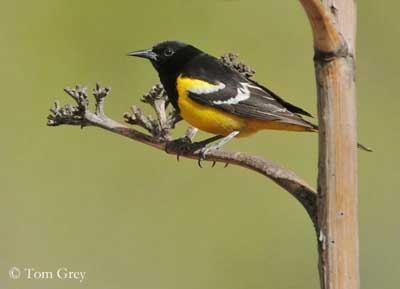
HABITAT:
The Scott’s Oriole is found in arid and semi-arid habitats, relatively elevated areas, desert slopes of mountains, foothills and semi-arid plains where Yuccas are common, between mountainous areas. It avoids real desert.
RANGE:
The Scott’s Oriole breeds in Southern California, Southern Nevada, Utah, Arizona, New Mexico and Western Texas.
It winters mainly south of the United States and Mexico border.
On February 20 and 23rd, 2007, one Scott's Oriole male has been sighted at a bird-feeder in Pennsylvania, very far from its range. It is a state record for this species normally seen in South Western United States.

BEHAVIOUR:
The Scoot’s Oriole often frequents feeders for sugar water, and takes nectar from different flowers species. It forages for insects in low vegetation and on the ground, but it also gleans and probes into dead, hanging-down leaves in Yuccas and trees.
The Scott’s Oriole usually hops on the ground. In trees and bushes, it climbs on limbs rather than flying.
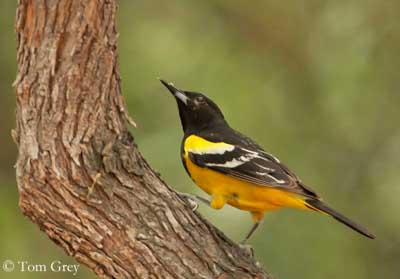
Aggressive behaviour may include close passes during flight chases, attacks and contacts with wings, feet and beaks, made in the air, perched or on the ground. Territorial behaviour shows mainly the males singing to each other from perches near nests. Alarm calls are given against intruders, with rapid perch changes.
The Scott’s Orioles are monogamous, and pair-bonds last a single season. The female often sings from the nest in response to the male song. The male follows her closely while she builds the nest, or searches for food or nest materials.
Courtship displays are not very well studied. But the male performs strong pursuit of female when arriving on the breeding areas. Then, the female perches at top of Yucca tree. The male drops to the ground, walking away from female with “exaggerated” gait. Then, it flies while singing.
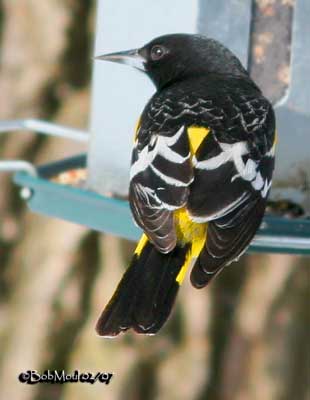
The female may perform precopulatory displays, during which she rapidly flutters the lowered and partially extended wings, while she utters trills in front of male.
During the breeding season, the Scott’s Orioles are found in pairs, and then, in family groups. They migrate in small flocks of 5 to 20 birds. They forage in mixed-species flocks in winter.
FLIGHT:
The Scott’s Oriole may fly long distances for feeding. It performs low flight, more undulating than other Orioles.
REPRODUCTION:
Usually, the nest building starts soon after pair forms and may continues for a long period. They breed in spring and summer. The nest is located in shrubs, and at branch base in tree canopy.
The Scott’s Oriole female builds a woven hanging nest. She pulls at and strips off long, string-like fibres from borders of Yucca leaves. Then, she weaves them together, in order to build the main part of the nest. She lines it with grasses and other soft materials. She needs about 6 to 10 days, and often sits for a few days before laying the first egg. The male perches at about 10 metres away, and follows her while she searches for materials.
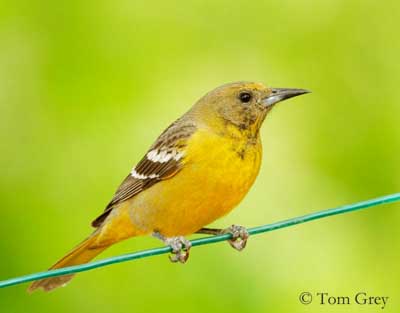
The female lays 3 to 4 bluish eggs, marked with black, grey, brown and purple. The incubation lasts about 11 to 15 days, by female, and begins after the second egg is laid. She incubates alone, and the male may sometimes bring food to her. It remains near the nest during the incubation period.
The altricial chicks have sparse tufts of pale grey to buff down. The female broods them, but they are fed by both parents with insects and fruits.
The young fledge about 9 to 15 days after hatching, and they fly weakly, only fluttering above the ground. They depend on parents for 2 to 3 weeks after fledging.
This species produces 2 to 3 clutches per season.
DIET:
The Scott’s Oriole feeds mainly on insects (adults and larvae) such as grasshoppers, small beetles, caterpillars and butterflies. It also consumes berries and cactus fruits, and nectar from flowers.
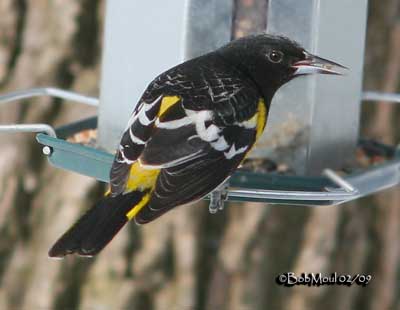
PROTECTION / THREATS / STATUS:
The Scott’s Oriole’s populations seem to be quite numerous. But this species is very dependent of Yucca trees for nesting and feeding. Habitat loss and decimation of Yucca by cattle grazing is an important threat for this species.
The Scott’s Oriole is preyed upon by reptiles, mammals and birds, such as jays and hawks.
However, the species is not currently threatened.
